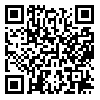BibTeX | RIS | EndNote | Medlars | ProCite | Reference Manager | RefWorks
Send citation to:
URL: http://jdc.tums.ac.ir/article-1-5547-en.html
Background and Aim: Microneedle technology has led to huge changes in the field of drug delivery medicine. Using microneedles, the drug can be injected locally, painlessly, and in very low and controlled doses with high precision. Local drug delivery through the skin with microneedles has many advantages over other methods of drug delivery. In this method, the drug does not enter the gastrointestinal tract and blood circulation, and therefore non-target organs are protected from the side effects of the drug. The present study is designed to construct an array of micron needles using the lithography method.
Methods: In this study, a silicon microneedle array is fabricated using the photolithography method with proper adjusting of the effective parameters. The constructed microneedle array has 256 needles with a height of 500 microns, a base diameter of 250 microns, and a center-to-center distance of 600 microns.
Results: Microscopic images show that the microneedles are tapered with a relatively sharp tip. Their surface is smooth and without cracks, and they also have an acceptable resemblance to the original design.
Conclusion: The produced microneedle array can be used directly to pierce the skin and increase its permeability by creating micron holes. In addition, this array can be used as a mold for the production of microneedles with malleable materials in the casting method.Received: 2021/12/28 | Accepted: 2021/11/6 | Published: 2021/11/6
| Rights and permissions | |
 |
This work is licensed under a Creative Commons Attribution-NonCommercial 4.0 International License. |



